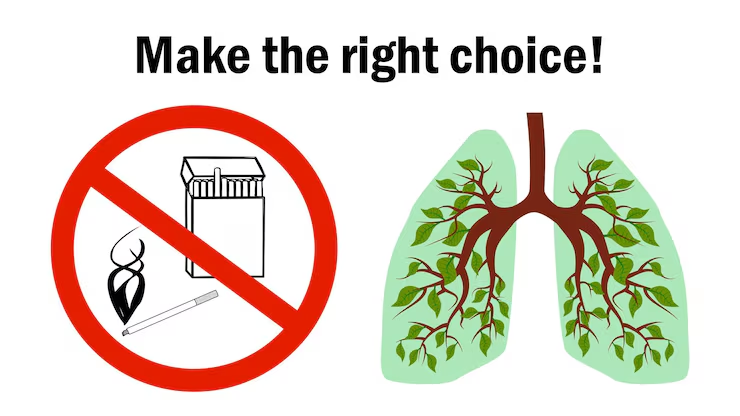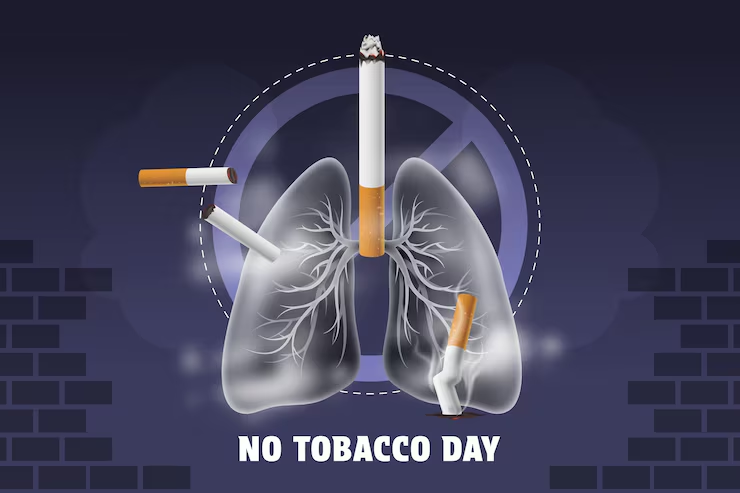Smoking is a major contributor to preventable diseases such as chronic bronchitis, emphysema, and lung cancer. Even after quitting, many ex-smokers may experience shortness of breath, coughing, or reduced lung function. However, the body begins to heal almost immediately once smoking stops, and over time, lung health can improve significantly.
To support recovery, it’s essential to understand how to improve lung health after smoking. Regular cardiovascular exercise, such as walking or swimming, helps strengthen the lungs and boost overall respiratory capacity. A diet rich in antioxidants from fruits and vegetables can also aid the healing process by reducing inflammation and supporting tissue repair.
In addition, practices like deep breathing exercises, staying hydrated, and avoiding polluted environments play an important role. For those wondering how to improve lung health after smoking, consistency in these habits is key. With time and care, many former smokers regain much of their lung function and overall vitality.
This comprehensive guide breaks down the top 8 most effective ways to improve lung health after smoking—with practical tips, natural remedies, and expert advice to get you breathing freely again.

Top Most effective ways to improve lung health after smoking
Deep Breathing and Lung Exercises
Deep breathing and lung exercises are powerful tools for enhancing respiratory function, especially for those recovering from smoking. These exercises help expand the lungs fully, increase oxygen intake, and remove lingering toxins. Over time, they can reduce shortness of breath and improve lung capacity, making daily activities easier and more comfortable.
Regular practice of lung exercises, such as blowing into a balloon or using a spirometer, also supports the lungs’ recovery. When considering how to improve lung health after smoking, combining these exercises with a healthy lifestyle can significantly accelerate the healing process and restore lung function over time.
Why It Matters:
Smoking weakens the lungs and restricts oxygen flow. Deep breathing exercises help expand lung capacity, enhance oxygen intake, and clear mucus and toxins from the lungs.
How to Do It:
Diaphragmatic Breathing: Also called belly breathing, it focuses on engaging the diaphragm for deeper inhalation.
Pursed-Lip Breathing: Inhale through the nose and exhale slowly through pursed lips. This keeps the airways open longer.
Incentive Spirometry: A tool that encourages deep breathing to strengthen lungs—often used in hospitals post-surgery.
Tips for Success:
Practice 5–10 minutes twice daily.
Combine breathing exercises with meditation or yoga for added benefits.
Gradually increase intensity over weeks.
Eat a Lung-Friendly Diet

Eating a lung-friendly diet is essential for former smokers who want to support their recovery and improve overall respiratory health. Nutrient-rich foods can help reduce inflammation, repair damaged lung tissue, and strengthen the immune system. This approach is especially beneficial for those seeking practical ways on how to improve lung health after smoking.
Understanding how to improve lung health after smoking includes making smart food choices. Limiting processed foods, sugary snacks, and salty items reduces strain on the lungs. A consistent, balanced diet not only supports lung healing but also improves energy and overall wellness.
Why It Matters:
Food plays a crucial role in detoxifying your body, reducing inflammation, and providing antioxidants that protect and heal lung tissues.
Top Foods for Lung Health:
Leafy Greens: Spinach, kale, and arugula reduce oxidative stress.
Citrus Fruits: High in Vitamin C, essential for immune and tissue repair.
Fatty Fish: Omega-3 fatty acids reduce inflammation.
Garlic and Ginger: Natural anti-inflammatory agents.
Turmeric: Contains curcumin, a compound that boosts lung function.
What to Avoid:
Processed meats
Sugary beverages
Fried and high-fat foods
Excess salt
Stay Hydrated to Flush Out Toxins
Staying hydrated is a simple yet powerful step in lung recovery after quitting smoking. Water helps thin mucus in the lungs, making it easier to clear out irritants and toxins that built up from smoking. Proper hydration also supports overall respiratory function and cellular repair.
If you’re exploring how to improve lung health after smoking, drinking plenty of water daily is essential. Herbal teas and water-rich fruits like watermelon and cucumbers can also contribute to hydration. Understanding how to improve lung health after smoking involves small daily habits like this that make a big impact on long-term lung health.
Why It Matters:
Water is essential for lung recovery. It keeps the mucosal lining in the lungs thin, which helps the lungs function better and expel mucus.
Hydration Tips:
Drink 8–10 glasses of water daily.
Add lemon or cucumber for extra antioxidants.
Herbal teas like peppermint, ginger, and green tea support detox.
Bonus: Steamy showers or humidifiers can also hydrate lungs externally.
Get Active With Cardio and Outdoor Exercise

Cardio and outdoor exercise are excellent ways to strengthen your lungs and improve overall health after quitting smoking. Activities like brisk walking, cycling, or swimming increase lung capacity and help clear out residual toxins from years of smoking. Fresh air also supports better oxygen intake and mental clarity.
When considering how to improve lung health after smoking, including regular physical activity is key. Even 20–30 minutes a day can make a noticeable difference. For anyone wondering how to improve lung health after smoking, staying active not only boosts lung recovery but also improves mood, energy levels, and heart health.
Why It Matters:
Exercise increases oxygen delivery, boosts circulation, and helps clear out tar and mucus from your lungs.
Recommended Activities:
Walking or Hiking: Low impact but highly effective.
Cycling or Swimming: Improves lung capacity.
Jogging or Aerobics: For those with better stamina.
Tips for Beginners:
Start slow; 15–20 minutes a day is enough.
Gradually build up endurance.
Avoid high-pollution areas—choose parks or trails.
Avoid Pollutants and Improve Indoor Air Quality
Avoiding pollutants and improving indoor air quality are crucial steps in supporting lung recovery after smoking. Dust, mold, pet dander, and chemical fumes can irritate the lungs and slow the healing process. Using air purifiers, keeping windows open for ventilation, and avoiding strong household cleaners can help create a healthier living environment.
If you’re focused on how to improve lung health after smoking, reducing exposure to harmful airborne particles is essential. Another key strategy in how to improve lung health after smoking is to avoid secondhand smoke and stay away from high-pollution areas when possible to protect your respiratory system.
Why It Matters:
Your lungs are already in recovery mode; don’t add further stress by inhaling more harmful particles.
Steps to Improve Air Quality:
Use HEPA air purifiers at home.
Avoid secondhand smoke, chemical cleaners, and strong fragrances.
Ventilate rooms by opening windows.
Add houseplants like snake plant and aloe vera to purify the air.
Use Natural Lung Detox Methods
Natural lung detox methods can support the body’s ability to heal after quitting smoking. Techniques like steam therapy, consuming anti-inflammatory herbs (such as ginger and turmeric), and practicing deep breathing can help loosen mucus and clear the airways. These methods gently assist the lungs in flushing out toxins.
When exploring how to improve lung health after smoking, including natural remedies can be a helpful complement to medical advice and lifestyle changes. Another aspect of how to improve lung health after smoking includes avoiding new toxins, eating clean, and giving your lungs the time and support they need to regenerate.
Why It Matters:
Natural remedies can support lung repair and help expel toxins like tar and nicotine residue.
Effective Remedies:
Steam Inhalation: Opens airways and loosens mucus.
Eucalyptus Oil: Natural decongestant and anti-inflammatory.
Honey and Lemon: Soothes the throat and acts as a natural antioxidant.
Licorice Root Tea: Calms inflammation and helps clear lungs.
Warning: Consult your doctor before using herbal supplements, especially if you’re on medication.
Sleep and Stress Management

Quality sleep and effective stress management are essential for lung recovery after quitting smoking. During sleep, the body repairs damaged tissues, including those in the lungs. Chronic stress, on the other hand, can weaken the immune system and slow healing. Techniques like meditation, yoga, and regular sleep routines promote both mental and physical health.
If you’re looking into how to improve lung health after smoking, prioritizing rest and reducing stress are key steps. Another part of how to improve lung health after smoking is creating a calm environment that supports healing, allowing your lungs and body to fully recover over time.
Why It Matters:
Sleep is when your body repairs itself. Chronic stress can weaken your immune system and slow lung recovery.
How to Improve Sleep and Reduce Stress:
Follow a regular sleep schedule.
Practice mindfulness meditation or yoga.
Use magnesium or lavender for relaxation.
Avoid screens 1 hour before bed.
Get Regular Health Checkups and Lung Screening
Regular health checkups and lung screenings are vital for monitoring recovery after quitting smoking. These appointments help detect any early signs of lung disease or complications, even before symptoms appear. Early intervention can make a significant difference in long-term outcomes and overall lung function.
When thinking about how to improve lung health after smoking, staying proactive with medical care is essential. Routine checkups allow doctors to track progress and recommend personalized steps. For anyone serious about how to improve lung health after smoking, regular screenings provide peace of mind and ensure you’re on the right path toward lasting recovery.
Why It Matters:
Even after quitting, former smokers remain at higher risk of lung diseases like COPD and lung cancer. Monitoring is essential.
What to Discuss With Your Doctor:
Lung function tests (spirometry)
Chest X-rays or CT scans (if recommended)
Symptoms like chronic cough, wheezing, or breathlessness
Vaccinations: Get flu and pneumonia vaccines to prevent respiratory complications.
Timeline of Lung Recovery After Quitting Smoking
| Time After Quitting | What Happens to Your Lungs |
| 20 minutes | Heart rate and blood pressure begin to drop. |
| 8 hours | Carbon monoxide levels in the blood drop; oxygen levels rise. |
| 48–72 hours | Nicotine is cleared from the body; breathing may feel easier. |
| 1–3 weeks | Lung function starts to improve; cilia begin healing. |
| 1–3 months | Coughing and shortness of breath decrease; lung capacity increases. |
| 6 months | Cilia are fully restored; lungs become more resistant to infection. |
| 1 year | Risk of respiratory illness and lung-related infections significantly drops. |
| 5 years | The risk of developing lung cancer begins to decrease. |
| 10 years | Lung cancer death rate drops by about half compared to a smoker. |
| 15+ years | The risk of lung disease approaches that of a non-smoker. |
Conclusion: Your New Breath of Life Starts Today

Quitting smoking is a powerful first step toward better health, especially for your lungs. As soon as you stop, your body begins to repair itself, and your lungs start clearing out toxins built up over the years. Breathing becomes easier, and your energy slowly returns.
Understanding how to improve lung health after smoking is key to speeding up this recovery. Regular exercise, a balanced diet rich in antioxidants, and hydration all support lung repair. Learning how to improve lung health after smoking also involves avoiding pollutants, managing stress, and getting regular checkups to monitor your progress.
Each breath you take now is cleaner and healthier. By following these steps and staying committed, you give your lungs the best chance to heal. Keep reminding yourself that your journey to wellness is ongoing, and knowing how to improve lung health after smoking will help you enjoy a longer, stronger, smoke-free life.
Healing your lungs after smoking isn’t just possible—it’s empowering. By following these eight proven tips, you’re not just recovering; you’re rebuilding your body, your confidence, and your quality of life.
Commit to the process. Give your lungs the support they need. With time, patience, and the right lifestyle changes, you can breathe easier, live longer, and thrive.
Quick Recap: Top Tips to Improve Lung Health After Smoking
Improving lung health after quitting smoking is not only possible—it’s powerful. Start with simple practices like deep breathing exercises and lung workouts to boost lung capacity and clear out toxins. These habits help your respiratory system function more efficiently over time.
A balanced lifestyle also plays a key role. Eating antioxidant-rich foods, staying hydrated, getting regular cardio exercise, and avoiding pollutants all contribute to recovery. If you’re serious about how to improve lung health after smoking, making these steps part of your daily routine is essential.
Don’t forget to prioritize rest, manage stress, and schedule regular health checkups. These small but consistent actions support long-term healing. Understanding how to improve lung health after smoking is about commitment and care—each healthy choice brings you closer to restored lung function and a better quality of life. Keep going—you’re already on the path to stronger lungs.
Practice Deep Breathing & Lung Exercises
Eat an Anti-Inflammatory, Lung-Boosting Diet
Stay Well Hydrated
Engage in Regular Cardio & Outdoor Activity
Avoid Air Pollutants & Improve Indoor Air
Use Natural Remedies for Detox
Prioritize Sleep & Manage Stress
Get Regular Lung Checkups & Screenings
FAQs
Q1. How long does it take for lungs to heal after quitting smoking?
Lung healing begins within days of quitting, but full recovery can take months to years depending on how long you smoked. Some damage may be permanent, but overall lung function usually improves significantly.
Q2. Can lungs completely recover after smoking?
While lungs can’t fully return to a “never-smoked” state, they can recover to a large extent. Cilia regenerate, inflammation decreases, and your risk of lung infections drops over time.
Q3. What are the best ways to improve lung health after smoking?
Regular cardio exercise, a healthy diet, hydration, avoiding pollutants, and deep breathing exercises are excellent strategies for how to improve lung health after smoking.
Q4. Is it necessary to see a doctor after quitting smoking?
Yes, regular checkups and lung screenings help monitor recovery, detect early problems, and guide you on how to improve lung health after smoking safely and effectively.
Q5. Do natural remedies help clean the lungs after smoking?
Yes, natural lung detox methods like steam therapy, anti-inflammatory herbs, and breathing exercises can support lung healing, especially when combined with medical advice and a healthy lifestyle.